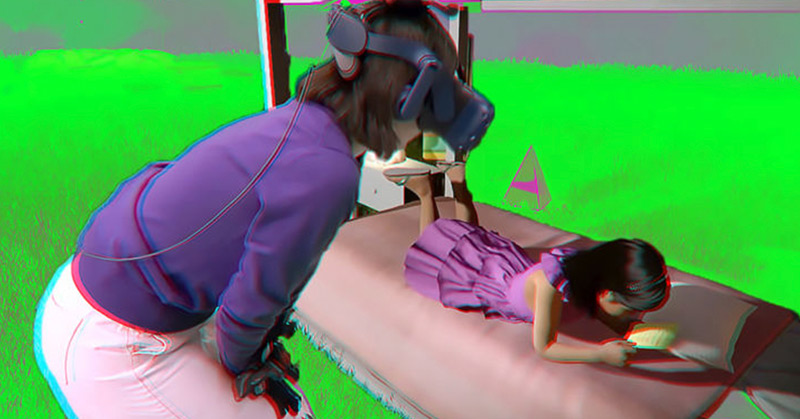The popularity of Virtual Reality (VR) has been advancing at a rapid rate. Across the world, the VR market volume is expected to reach nearly 98 and a half million in sales by 2023, with China leading the way in terms of population penetration [1].
Of course, VR as an immersive video game experience can be very fun, but as the technology is becoming increasingly sophisticated, it is starting to be used in impactful ways that extend far beyond simple entertainment.
A Mother-Daughter Reunion
After Jang Ji-sing’s seven-year-old daughter passed away in 2016 of an incurable disease, she was heartbroken. Three years later, she was given the opportunity to reunite with her deceased daughter thanks to VR technology [2].
The production team spent eight months designing the virtual park modeled after the one the mother and daughter used to visit in real life. They recorded the movements of a child actor using motion-capture technology that they later used as a model for the virtual version of Jang’s daughter, Nayeon.
The experience was life-like enough to move the South Korean mother, as well as family members who were observing, to tears.
“Maybe it’s a real paradise,” Jang said of the reunion in VR, according to Aju Business Daily. “I met Nayeon, who called me with a smile, for a very short time, but it’s a very happy time. I think I’ve had the dream I’ve always wanted.” [2]
Read: A Clinical Psychologist Explains Why Grief Isn’t Something to Just Get Over
What Else Can VR Do?
The possibilities of virtual reality technology seem endless. The immersive experiences offered through VR can have a deeply impactful social impact and can provide users with the opportunity to develop empathy for others in a way that was not possible before.
Carne y Arena, which means Flesh and Sand, is an immersive experience that places the user in the middle of the Sonoran Desert with immigrants who reach the border of the United States but are then stopped by border control. It allows the user to experience first-hand the difficulties and emotional pain experienced by immigrants, and what is motivating them to immigrate in the first place. The VR experience turns otherwise impersonal stories into reality and has the power to change perspectives and create a more empathetic society [3]
VR Makes the World More Accessible
This immersive technology has a unique impact on the accessibility of global travel. For people who are elderly, physically challenged, or underprivileged, travel is not often a possibility. With VR, however, these people can not only see the world but actually be in the world- they have the potential to travel anywhere they wish virtually.
Google’s Arts and Culture site allows anyone to visit over twelve hundred of the greatest museums in the world, without leaving their living room. This gives everyone the opportunity to have these educational and enriching experiences, not just those who are able to afford it [3].
The Medical Benefits of VR
Virtual reality is now being used to help cancer patients reduce pain after surgery, by immersing them in a world of cool or light, the company Firsthand Technology helps patients to refocus their bodies and their minds. This strategy is being reported to be as effective as opiates at reducing pain in these individuals. [3]
A study led by Dr. Shorin Nemeth, Medical Director for Pain Services and Medical Director for Oncology Palliative Care at Providence Health and Services in Portland, Oregon, found that patients who used the technology reported thirty percent less pain and saw a twenty percent reduction in their use of opiates [4].
VR Helps Tackle Fears
Psios is a VR company that is leading the way in VR applications for improving mental health. The company’s platform contains over seventy virtual reality environments to use with exposure therapy to help people get over debilitating fears. According to the company’s website, the technology allows mental health professionals to adapt and control virtual scenarios that mimic real life in order to best help their clients.
“This technology allows mental health professionals to evaluate and identify their client’s fears and anxieties within the safety of a consultation room. VR is a tool that effectively facilitates the application of psychological evaluation and intervention protocols.” [5]
Are There Risks With Using VR?
Virtual Reality is still new and is advancing so quickly that it is difficult as yet to determine all of the outcomes of the technology. Because the experiences with VR are so immersive, there is the risk that the user could experience very real trauma, and could even develop PTSD if they are placed in extreme or violent scenarios, like a war game, for example. This has lead many people and companies in the industry to push for content standards [3].
In the case of Jang Ji-sing’s experience, the prospect of being able to bring deceased loved ones “back to life” carries some potentially dangerous risks. Perhaps the technology could help people find closure following a death, but it has the potential to go the complete opposite direction, causing the user to become addicted to the virtual world in which their loved one exists, and withdrawing from the real world [2].
There are many potential benefits to VR technology, and there are many applications of the technology that we are not yet aware of that could have a positive impact on society. Of course, as is always the case with technology, it is important to proceed with extreme caution, since the consequences of VR are still widely unknown.
Keep Reading: How to Deal with Grief: Beautiful Advice from an Old Man
- https://www.forbes.com/sites/solrogers/2019/06/21/2019-the-year-virtual-reality-gets-real/#2022d9c06ba9
- https://futurism.com/watch-mother-reunion-deceased-child-vr
- https://www.forbes.com/sites/petercsathy/2019/10/07/vrs-surprising-benefits–serious-risks/#2b9fdaca1de4
- https://199.250.210.149/~firsth14/wp-content/uploads/Firsthand-Providence_VR_CaseStudy.pdf
- https://psious.com/benefits-virtual-reality-psychology/

